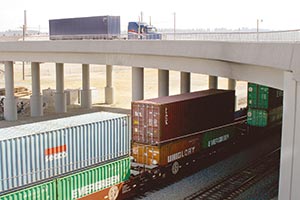Intermodal Rail Traffic Up as Turnaround Takes Hold

This story appears in the Feb. 13 print edition of Transport Topics.
Intermodal rail traffic grew slightly in the fourth quarter, but it wasn’t enough to reverse a 2.1% decline in total volume for 2016, according to the Intermodal Association of North America.
Container and trailer traffic in the last three months of the year rose 1% versus the prior year. Domestic container transportation grew 3.4% to 1.9 million industry-standard 20-foot equivalent units and international containers increased 0.6% to 2.1 million TEUs, but trailer traffic fell 9.2% to 331,964 units.
Full-year totals revealed how difficult it was for intermodal business, due in part to cheap truck prices, according to industry analysts. Total volume fell to 17.1 million units from 17.5 million in 2015. International container traffic dropped 3.3% to 8.5 million TEUs, and trailers plunged 23% to 1.2 million. The lone bright spot was domestic container traffic, which increased 4% to 7.4 million.
“There were no real surprises in the fourth quarter,” said Todd Fowler, industry analyst with KeyBanc Capital Markets Inc. “2016 was a transition year, where there was still an impact from the port disruptions in 2014 and 2015 and the excess truck capacity.”
“Traffic volumes experienced high levels of fluctuation throughout the first three quarters,” said Joni Casey, CEO of IANA. “These trends started to temper as of November, and international and domestic container volumes continued through December as well as into January, seeming to indicate that intermodal has turned the corner and is on a moderate upward path.”
Fourth-quarter results varied by origin and final destination. Corridor traffic dropped 4.4% between the Southwest, including Los Angeles and Long Beach, California, and the South Central. On the other hand, intermodal volumes to and from the Midwest grew between 1.4% and 4.3%.
Kevin Lhotak, president of Reliable Transportation Specialists Inc., told Transport Topics that his truck-rail business in Chicago matched the IANA results. He said importers have spread out their holiday season shipments rather than having a big push in July, August and September. He also believes Hanjin Shipping Co.’s bankruptcy filing and the presidential election caused uncertainty in the third quarter.
“The fourth quarter seemed to be OK. It wasn’t great, but it kept the trucks running and drove revenue,” Lhotak said. “It wasn’t the best fourth quarter we’ve ever had, and it wasn’t the worst, but versus the third quarter, we definitely saw more volume.”
However, Dave Manning, president of TCW Inc. in Nashville, Tennessee, said the fourth quarter was worse than previous quarters. His trucking company hauls cargo from the BNSF Railway, CSX Corp. and Norfolk Southern Corp. intermodal terminals in Memphis, Tennessee.
“For us, the trend is that the second and third quarters are our busiest quarters. I think importers want to stop cutting it close for the fall push and are starting a lot earlier,” Manning said. “Overall, demand was relatively flat in 2016, but we saw more demand in the second and third quarters than we did in the first and fourth.”
IANA noted a significant change in the relationship between international trade and containers. In 2016, container imports rose 3.7% at U.S. ports, but international containers on intermodal dropped 3.2%. During the prior five years, the two variables directly correlated with each other.
Transloading, or transferring cargo from an international to a domestic container, is one reason behind the shift, according to IANA. One benefit is that an importer can transfer cargo from three international containers into two 53-foot domestic containers, cutting costs.
“If you look at the overall numbers relative to the size of the domestic container market, it’s clearly contributing, but I don’t think it’s the only thing because it’s not a large enough share,” said Anthony Hatch, an independent rail analyst. “There are advantages to transloading, but it’s another handling where mistakes can be made. The handling is also an additional cost.”
For steamship lines or container lessors, transloading means their equipment isn’t being transported across the country.
“Because our dollar is stronger, exports are down. So the steamship lines don’t want to get their 20- and 40-foot containers stuck. They don’t want to send 200 imports to Chicago when they know they’re only going to have 20 exports. When you transload, you keep the international container close to the port,” Lhotak explained.
IANA predicted that 2017 will be a stronger year for intermodal rail because trucking capacity will tighten in the run-up to the electronic logging device mandate. Unless there is an economy disruption, the association wrote, this year’s fourth quarter will be robust.




